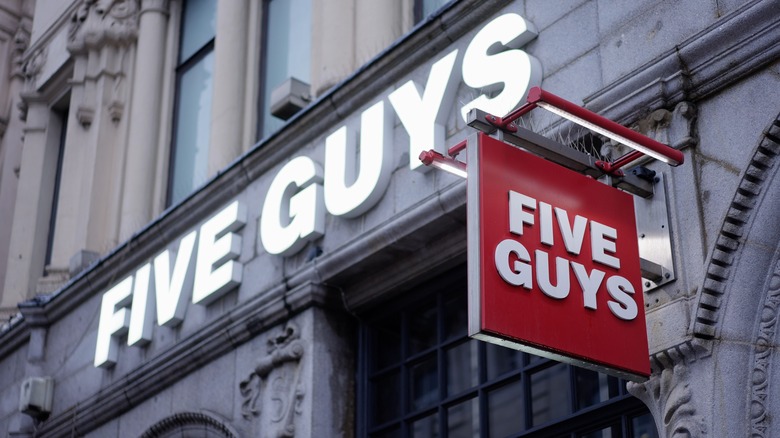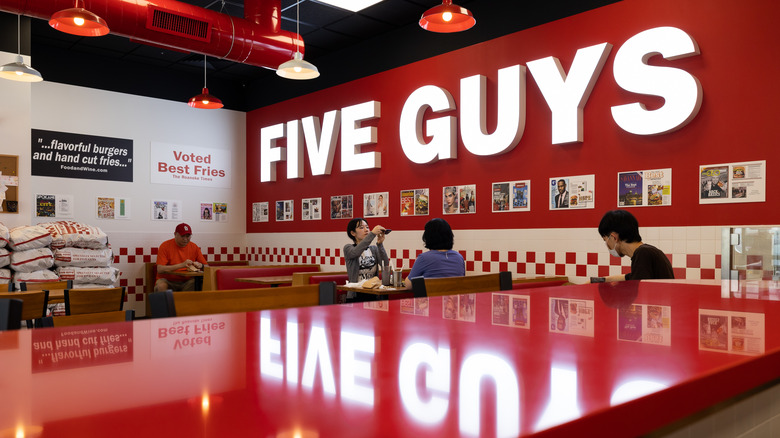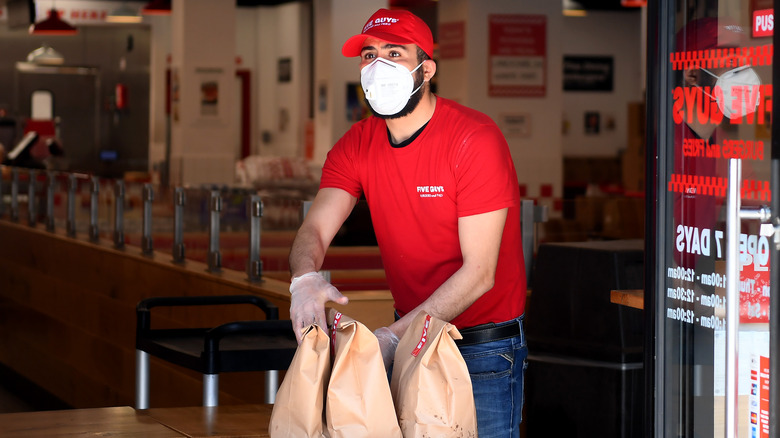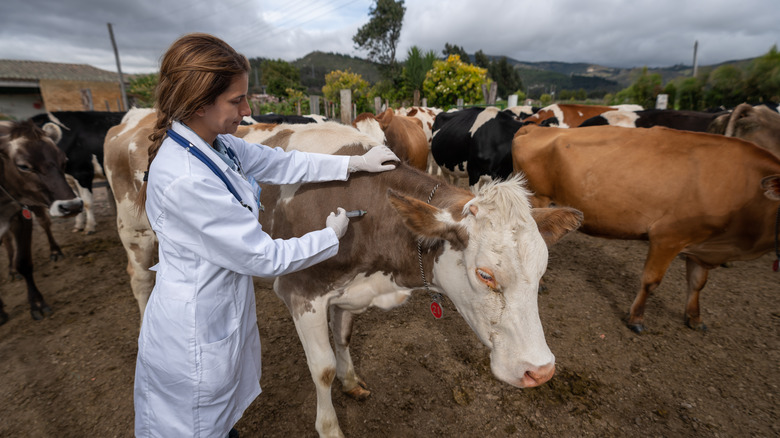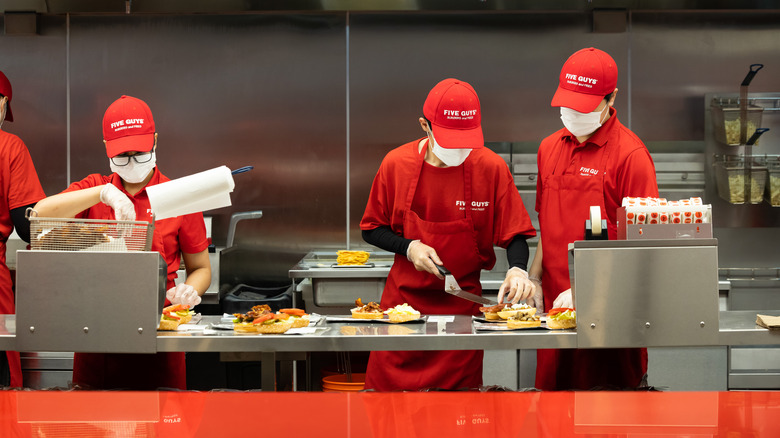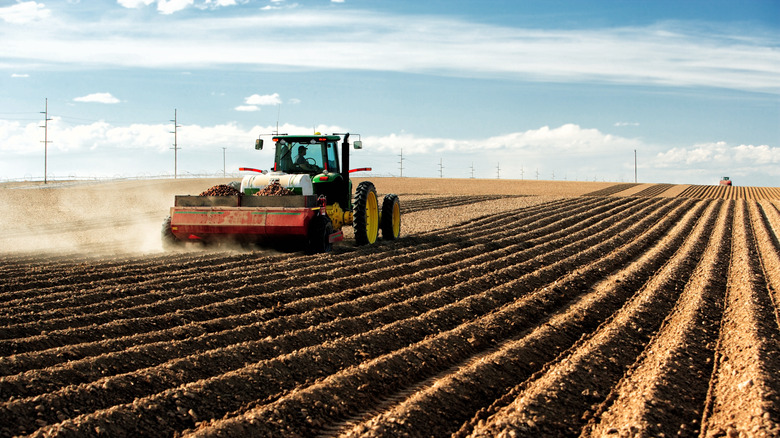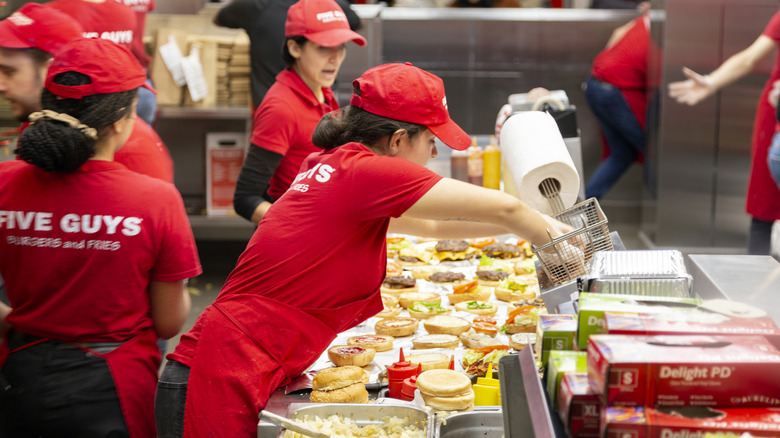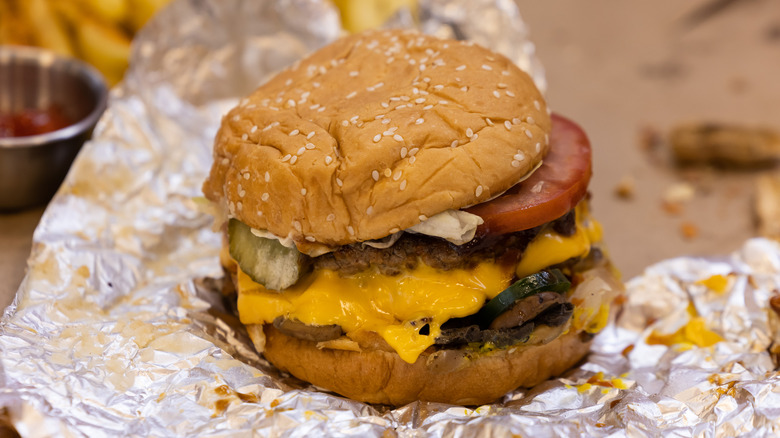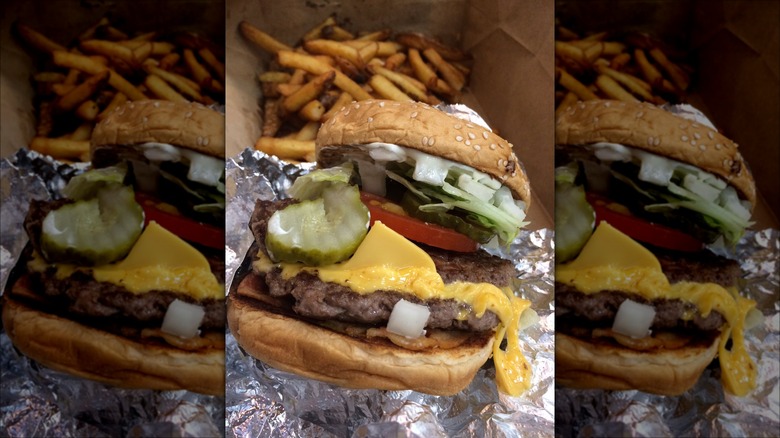11 Surprising Facts You Might Not Know About Five Guys
Founded in 1986 as a lone burger shop, Five Guys has since grown into an internationally respected fast food brand. Today there are some 1,700 Five Guys restaurants open around the world, and this number is rapidly expanding. In the United Kingdom alone, Five Guys plans to open around 150 new restaurants in the coming years.
Five Guys' growth can be put down to a number of factors. The brand has built a reputation for serving fresh, high-quality, delicious food including french fries that are prepared in-house. Fans also adore Five Guys for the near-endless combinations of free toppings that can be added to any burger or hotdog.
While many are quick to shout about the positives of eating at Five Guys, like all brands it does have its negatives. In this article we expose both the good and the bad aspects of Five Guys through different facts you probably don't know.
1. Five Guys does not invest in paid advertising
Unlike McDonald's, Burger King, or many other multinational fast food brands, Five Guys does not invest in paid advertising. The brand also refuses to run promotions or limited-time offers. This stands Five Guys in direct contrast to other fast food brands. According to Statista, McDonald's spent nearly $400 million on global advertising in 2022 alone. What's more, McDonald's also runs at least one promotion in every store.
While it seems that refusing to spend on advertising could damage Five Guys' growth potential, the opposite is actually true. By relying on word-of-mouth, and building an instantly recognizable brand image through careful interior design and packaging choices, Five Guys has developed an incredibly strong brand identity.
Interestingly, Five Guys does lean into free digital advertising in the form of social media. Five Guys is prolific on Facebook, posting regularly and engaging with customers. On Instagram, Five Guys encourages fans to post photos of their Five Guys experience which the brand subsequently reshares. This results in a huge amount of advertising for the brand that's created free of charge.
2. Five Guys did a U-turn on its no delivery policy
For a long time, Five Guys did not deliver at all. On one famous occassion, the brand even refused to deliver burgers to the Pentagon. The brand's reason for not doing delivery was succinctly explained to QSR Magazine by Five Guys founder Jerry Murrell: "We've never had a delivery service. We don't believe in it. We think it cheapens the product."
Murell's words have not aged well. Since 2019, Five Guys has been delivered in the United States via Postmates. In the United Kingdom, Five Guys has doubled down on delivery, signing partnerships with the likes of Just Eat and UberEats.
In 2021 it was revealed that Five Guys opened its first U.S. ghost kitchen. Based in Garland, Texas, this ghost kitchen only caters for delivery orders, a clear indication that Five Guys is now immensely invested in the delivery aspect of its business.
3. It sources beef from cows that have been raised on antibiotics
Five Guys often boasts of its superior quality meals. Everything is fresh, much is made in-house, and there are no freezers on site to boot. This makes it all the more surprising that Five Guys has been shown to use meat from cows that have been reared on antibiotics. In a report created by a myriad of organizations including the Center for Food Safety, Consumer Reports, and Friends of the Earth (via CBS News), Five Guys was given an F grade for lacking a policy that ensures its beef does not come from cows that have been reared on antibiotics.
While other brands that received an F grade pledged to transition away from antibiotic-riddled beef, Five Guys did not. In the following years, Five Guys has never announced a policy against using beef raised on antibiotics. It can therefore be assumed that all American Five Guys restaurants still use meat from cattle that have been reared on antibiotics.
What makes this choice all the more surprising is that, outside of the United States, Five Guys does make its burgers from predominately antibiotic-free beef. In the United Kingdom, for example, Five Guys sources its beef from Scotland, a country that has strict laws on antibiotic use in farming.
4. Strict kitchen policies are in place at Five Guys
Like all fast food restaurants, Five Guys cherishes consistency. Consequently, the brand has several strict kitchen policies that all staff members are expected to follow. This involves a formulaic approach to burger assembly wherein certain toppings go either on the top bun or the bottom bun. For example, lettuce, onion, and pickles are top bun toppings, whereas bacon, mushrooms, and jalapeños are bottom bun toppings. What's more, tomatoes must always be the last topping stacked on the top bun.
Other rules apply elsewhere in the kitchen. French fries must be shaken 15 times to get rid of excess oil before they are served. Boxes of bread must also be stacked in a particular way.
While Five Guys prioritizes consistency, the company does not use timers in its kitchens. This is in contrast to the kitchens of other fast food restaurants where meat cooking is timer-controlled. This anomalous company policy is enforced as Five Guys believes that good cooks should instinctively know when food is done.
5. There have been significant gender pay gaps
In 2017, a lawsuit was filed by Jody Finefrock, a Pennsylvanian Five Guys employee, against the restaurant brand. In it Finefrock alleged that herself and other female employees were consistently paid less than the male members of staff even though they had the exact same jobs. This was most clearly demonstrated when Finefrock was promoted to general manager; she discovered that other male general managers were earning $2,000 a year more than her. After making initial complaints in 2015, Finefrock was fired by Five Guys.
Unfortunately, gender pay discrepancies are not limited to Five Guys located in the United States. In 2021, Five Guys UK released its Gender Pay Report. The report found a mean pay gap of 11.6%. There was also a large discrepancy in the bonuses given to female and male employees.
Such shocking statistics led Five Guys UK to implement several programs designed to tackle the wage gap. These included an Equality, Diversity and Inclusion Policy as well as a Women in Leadership program. These initiatives had their desired impact; in Five Guys' 2022 Gender Pay Report the mean pay gap had dropped to 4.5% while the mean bonus gap fell to 41.7%. Of course, equality is still a long way off.
6. Five Guys take staff uniform seriously
As with those at many other fast food brands, Five Guys employees have to wear an instantly recognizable uniform. For most crew members this involves pairing a red company t-shirt and baseball cap with jeans and black, non-slip shoes. Management wear a different style of top.
Aside from being expected to keep their uniform clean and professional in appearance, employees are also prohibited to perform certain actions while wearing it. For example, smoking in the Five Guys uniform is not allowed. This means that employees wishing to smoke on their break must change out of the uniform before doing so.
Five Guys employees are also forbidden from drinking alcohol in their Five Guys uniform. The only exception to this rule is during work events. Failing to adhere to the rules surrounding uniform can result in disciplinary actions being taken by management. Ultimately, this can lead to an employee's dismissal.
7. Five Guys sources potatoes from above the 42nd parallel of the equator
Five Guys has become known for its french fries. These boardwalk style fries are made in-house every single day, a stark contrast to many other fast food brands that ship in precooked, frozen fries. While Five Guys' fries are meticulously prepared in-house by being washed and then fried twice, the brand's attention to detail actually extends all the way back to where the potatoes are sourced from.
In a Facebook post, Five Guys stated that most of the potatoes used by the brand come from Idaho and are grown north of the 42nd parallel of the equator. When these potatoes can't be used, those from an even higher latitude are used as Chad Murrell, one of Jerry Murrell's five sons, explained to Food Republic: "We've perfected the process now, so all our potatoes are Burbanks from Idaho except for two months of the year, when the Idaho potatoes are too soft for us to fry in peanut oil since they absorb too much. Then we use 'gap potatoes,' Norkotahs out of Washington."
8. Five Guys' burgers are unhealthy
Thanks to its reputation for making fresh food in-house every day, many people assume that the food at Five Guys is inherently healthier than that served by other fast food restaurants. This is not the case. Most of its burgers, for example, are not among the healthiest things you can order at the restaurant.
A McDonald's Big Mac is made from two beef patties, American cheese, Big Mac sauce, and toppings like lettuce and chopped onions. A Big Mac contains 590 calories, 34 grams of fat, and 1050 milligrams of sodium. For comparison, a Five Guys cheeseburger, which is also made of two beef patties, American cheese, and a sesame seed bun, contains 980 calories, 55 grams of fat, and 1050 milligrams of sodium.
It's important to remember that these numbers do not take into account any of the 15 complimentary toppings available on Five Guys' burgers. This can mean that Five Guys' perfectly juicy burgers are even more unhealthy than the nutritional information would suggest, especially if you like highly calorific toppings like bacon and mayonnaise.
9. Five Guys have not always respected worker's rights
California has very clear laws when it comes to employees' rights to rest. These include an unpaid 30-minute meal break if they work more than five hours a day and a 10-minute rest for every four hours they work. Despite the clarity of these rules, 2,206 Five Guys employees in California were found to have been denied their right to breaks. These employees were not only denied their breaks but were also not paid overtime for working extra hours nor reimbursed for using their personal vehicles to perform work-related duties.
Five Guys settled the case in 2018, but it has taken a long time for an agreement to be finalized. In May 2023, a new agreement of $1.2 million was made. This means that each employee involved in the case will be able to claim around $900 in damages.
10. Buns are one of the few proprietary items on the menu
While many fast food brands rely on an extensive range of proprietary items to set themselves apart, Five Guys only uses a few. The most prominent proprietary item used by Five Guys are the buns. Both the brand's hot dogs and burgers come layered between a sweet roll that is quite different from those used by other fast food franchises.
In Five Guys' early days, all buns were provided by a single baker. However, as the brand has grown, more and more suppliers have had to be found. Becoming a bread supplier for Five Guys is no easy feat, as Robin Jones, managing director of a bakery that supplies Five Guys in the United Kingdom, explained to British Baker: "They sent their top bakery team from the States to sign off on the buns and the rolls. If they do not sign it off, you do not supply them. It's as simple as that. You have to have their seal of approval."
11. The cost of toppings is factored into menu pricing
Five Guys has a reputation for being generous. Diners can order any number of toppings for free, extra french fries are chucked into the bag with every order, and even soft drinks are endlessly refillable. While this approach gives the appearance of nonchalant generosity, it is actually a carefully thought out policy.
A meal at Five Guys usually costs about twice as much as a similar meal at McDonald's. One of the reasons for this is that all these 'freebies' are actually factored into the cost of the meal. Even if a person orders all the toppings and has a heaping helping of french fries, the restaurant will still make a profit. Of course, those that do not choose numerous toppings are paying over the odds for their burger or hot dog and are effectively subsidizing those that do.
